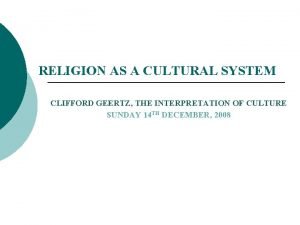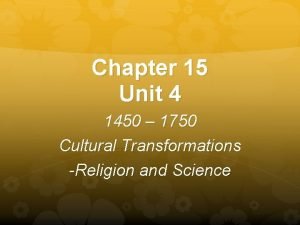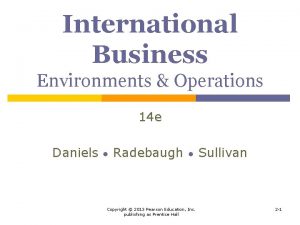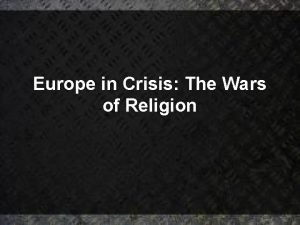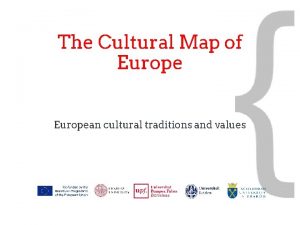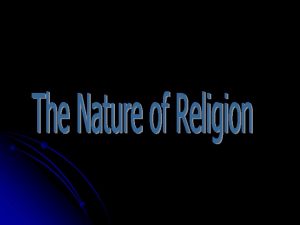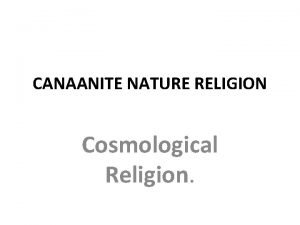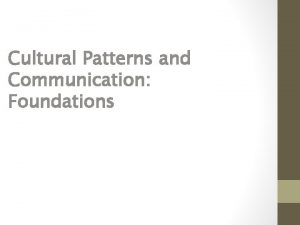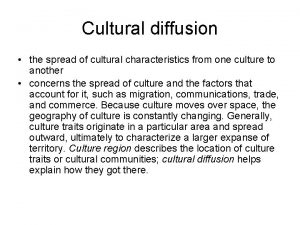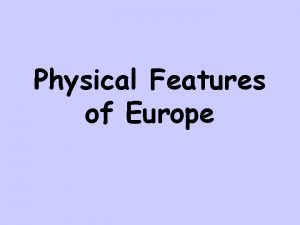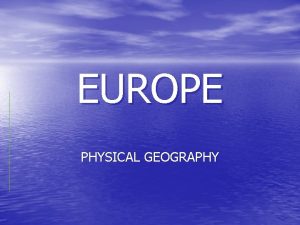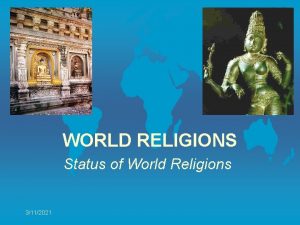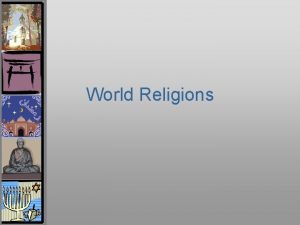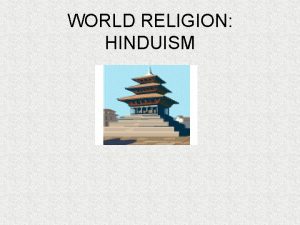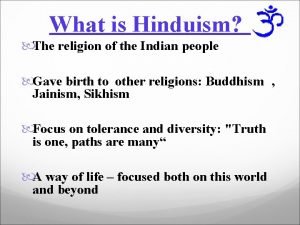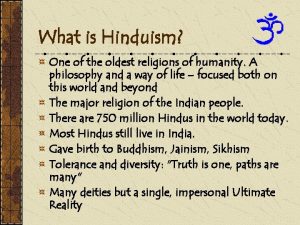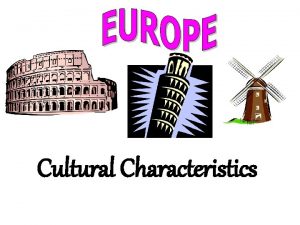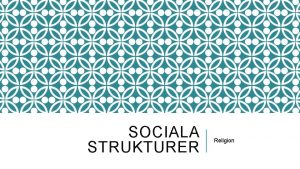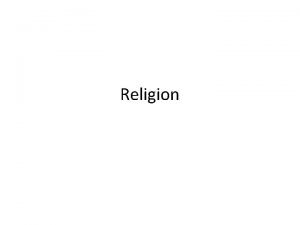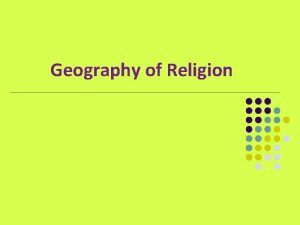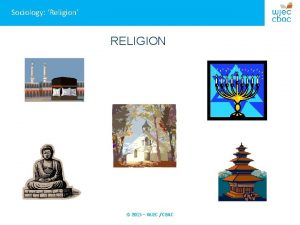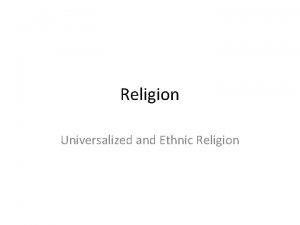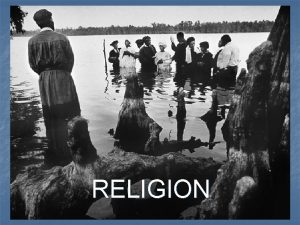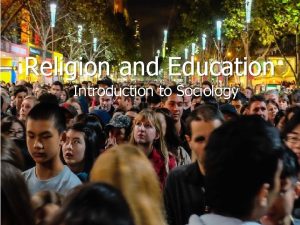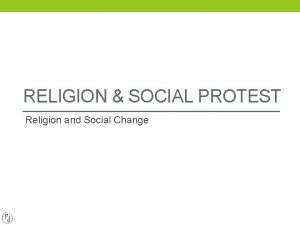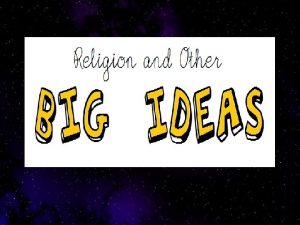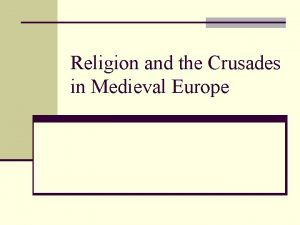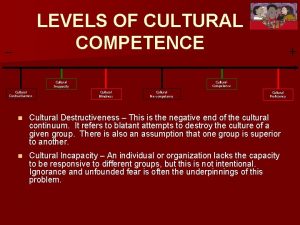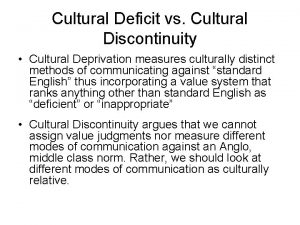Cultural Characteristics of Europe Religion In Europe is




















- Slides: 20

Cultural Characteristics of Europe

Religion In Europe is home to many religions n There are three main religions n These are Judaism, Christianity, and Islam n These religions have some similarities and even a common history n Monotheism (the belief in one god) is cental to all three religions

Religion In Europe n They are also different in their beliefs about God and man. n Sometimes these beliefs cause disagreements between people. n Disagreements can even happen between people of the same religious group.

Europe Today n n Religion has been very important in the history of Europe. Wars have been fought, and government leaders have been changed, because of religious issues. Today, most Europeans have the legal freedom to choose their religion. Most Europeans recognize and respect the rights of others to choose their own religion.

Judaism n Founder- Abraham (about 2000 BC) n Holy Book- Torah n Name of Followers- Jews n Number of Followers Worldwide- 15 million

Important Facts of Judaism n n n Torah is the first five books of the writings of Moses, believed to be given to Moses by God at Mt. Sinai Talmud is the written version of the Oral Law belief is in the laws of one God and the words of his prophets actions and following the laws are important Three main types of Judaism are: Orthodox (most traditional), Conservative and Reform (least traditional) Jews in Europe were nearly wiped out by Hitler and Nazi Germany (Holocaust)

Christianity n Founder- Jesus Christ (30 AD) n Holy Book- Bible n Name of Followers- Christians n Number of Followers Worldwide- 2. 1 Billion

Important Facts of Christianity n n n the five books of Moses make up the first five books of the Bible beliefs are based on the teachings of Jesus: love of God and neighbor, a regard for justice, a belief that Jesus is the Son of God Christianity is divided into 3 major groups: Eastern Orthodox, Roman Catholic, and Protestants include Anglicans, Baptists, Methodists, Presbyterians, Episcopalians and other non-Catholic, and non-Orthodox Christians Christianity is in most parts of the world today

Islam n Founder- Muhammad (about 610 AD) n Holy Book- Koran (Quran) n Name of Followers- Muslims n Number of Followers Worldwide- 1. 3 Billion

Important Facts of Islam Muslims believe that Muhammad was the last of the prophets, which included Abraham and Jesus n the main duties of Muslims are called the Five Pillars n – – – are prayer giving to charity belief in and submission to one God (Allah) fasting during the month of Ramadan a trip to Mecca once in a lifetime (Hajj) the two largest groups of Muslims are the Sunnis and the Shiites; the Sunnis account for 90% of the world’s Muslims n it is the main religion of the Middle East, North Africa, and Asia number of followers is rapidly growing n

Europe Languages n The continent of Europe is slightly larger than the United States in land area. n Europe’s population is more than double the population of the United States. n In the United States, English is the dominant language.

Europe Languages n Europe is much different. n It is home to more than two hundred native languages. n A few languages are dominant, but many more are spoken by large numbers of people.

Germanic Language n Most European languages are in three main categories: Germanic languages, Romance languages, and Slavic languages. n The Germanic language group has the most native speakers. n European native speakers of this group live mostly in northwest and central Europe.

Germanic Language n About 20 percent of Europeans speak one of two languages—English and German— as their native language. n Most Europeans learn English as a second language in their schools even if they don’t speak English at home.

Romance Languages n languages, which includes French, Italian, and Spanish. n These languages are found in the south and west of Europe. n These languages come from Latin, the language of the ancient Roman Empire.

Romance Languages n The Roman alphabet is used to write both Romance and Germanic languages, although not every language has the exact same characters and punctuation.

Slavic Languages n Slavic languages include Russian. Slavic languages are found in central and eastern Europe. n These languages do not always use the Roman alphabet. n They are written with a Cyrillic alphabet. Russian, for example, uses the Cyrillic alphabet.

Why is language a problem? n Having so many languages can be a problem. n It is difficult to live, work, and trade with people who cannot communicate with each other. n Europeans have worked hard to solve this problem. n Most schoolchildren learn one or two other languages besides their own.

European Union n The European Union has twenty-three “official” languages to make sure that people can understand laws and decisions made by the government. n There are special laws to protect languages too. n Europeans want to keep alive the languages spoken by only a few people. n At the same time, they are working to build a unified Europe.

Summary n Describe three different groups of languages in Europe. (include the name and where they are spoken n Why is language such a problem in Europe? n Create a triple Venn diagram on the three religions of Europe.
 Western religion vs eastern religion
Western religion vs eastern religion Religion as a cultural system
Religion as a cultural system Ursula de jesus ap world history
Ursula de jesus ap world history Cultural transformations religion and science
Cultural transformations religion and science International business daniels 15th edition ppt
International business daniels 15th edition ppt Europe in crisis the wars of religion
Europe in crisis the wars of religion The cultural geography of europe chapter 12 answer key
The cultural geography of europe chapter 12 answer key Europe cultural map
Europe cultural map .#
.# Describe the nature of the canaanite religion
Describe the nature of the canaanite religion Cultural pattern definition
Cultural pattern definition Cultural characteristics
Cultural characteristics Which political cultural and economic characteristics
Which political cultural and economic characteristics Characteristics of cultural diffusion
Characteristics of cultural diffusion Physical features in europe
Physical features in europe Physical characteristics of europe
Physical characteristics of europe India religion map 2021
India religion map 2021 Is baha'i ethnic or universalizing
Is baha'i ethnic or universalizing Religion root word
Religion root word Where did hinduism originate
Where did hinduism originate What is the oldest religion
What is the oldest religion

